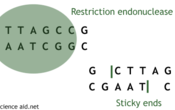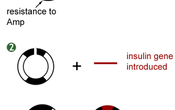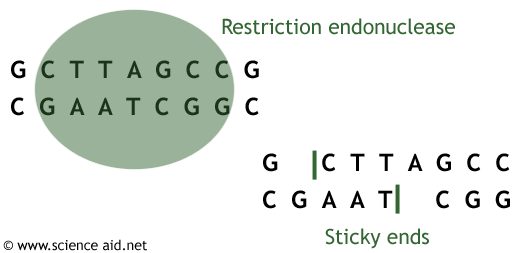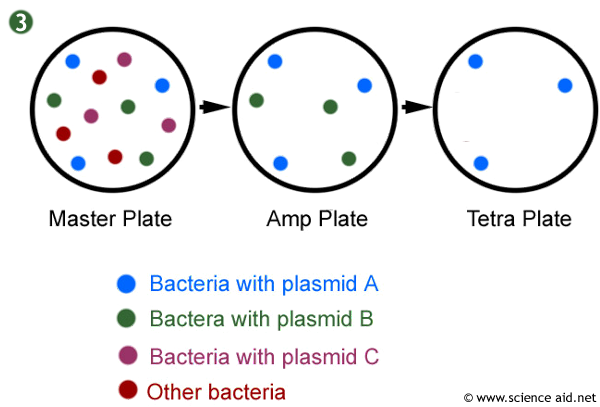Genetic Engineering, sticky ends using plasmids and bacterial culture
Edited by Jamie (ScienceAid Editor), Taylor (ScienceAid Editor)
Sticky Ends
In carpentry, you use saws and nails to remove things and stick them together, in Biology we use enzymes.
- 1The first type of enzymes are restriction endonucleases (restriction enzymes). Their job is to cut a strand of DNA in a specific area of the code called a recognition site. Genetic engineers have a large number of restriction endonucleases for different recognition sites, so that cuts can be made in specific places.Restriction Enzymes.Advertisement
- 2The opposite of that is DNA ligase, which put together two strands of DNA as opposed to a single strand which DNA polymerase does.DNA Ligase.
After the DNA has been removed using this enzyme, you get sticky ends at the end of the fragment and it's 'sticky' because it wants to become part of a DNA strand again.
Using Bacteria
A common method in genetic engineering is to find a gene for a useful product (e.g. insulin) and get a microorganism to produce it.This is done using a vector which carries things between species. When using bacteria, the vector is the plasmid which is a circle of DNA found in bacterial cytoplasm. It can be opened easily to allow a DNA fragment to be inserted into it. The vector can be encouraged to enter the cell by heat shock, where the temperature is raised rapidly from 0 to 40°C. Alternatively, you can also use electroporation, where a high voltage is used to disrupt the cell membrane.
The above steps show how the gene is added to a plasmid. The plasmid already has a gene for antibiotic resistance to Tetracycline and Ampicillin - as shown by the black areas. Then a restriction endonuclease is introduced that will cut the gene in between the Tetracycline resistance gene. Here, an insulin gene is added.
At the bottom of the diagram shows the possible outcomes of this situation.
- 1#Plasmid B shows that the insulin gene has been accepted into the the sticky ends, and now disrupts the Tetra resistance gene.Plasmid A shows there has been no change because the plasmid rejoined after being cut, or was never cut.
- 2Plasmid C shows that the insulin gene has curled up into the it's own little plasmid.
There is another situation of plasmid, which is the same as B, however instead of an insulin gene disrupting the Tetra resistance gene, it's another gene fragment (that we aren't interested in). For simplicity of explanation this has been omitted.
In step 3, the different bacteria with these plasmid are cultured. Using a process called replica plating where a piece of velvet is put on top of the master plate bacteria, then transferred to make a copy onto the next. The cultures are next grown on a plate containing Ampicillin, this will kill the bacteria without the resistance to the gene, i.e bacteria with plasmid C (ring on insulin) and bacteria without our plasmid at all. What is left on the Amp plate will be bacteria with plasmids A and B (see diagram above this one). These are now transferred to a final plate containing Tetracycline. This will kill bacteria containing plasmid B because the Tetra. resistance gene has been disrupted by the insulin gene. Now all we have to do is compare the bacterial colonies to see where the insulin containing bacteria are.
Culturing
Now that we have identified the bacteria that can produce insulin, we need to get it manufactured on a large scale; this can be done using fermentation. The microorganisms are put into the fermenter which provides the optimum conditions for bacterial or fungal growth, including nutrients like amino acids to make the protein, oxygen for respiration and warmth to keep them happy.
Referencing this Article
If you need to reference this article in your work, you can copy-paste the following depending on your required format:
APA (American Psychological Association)
Genetic Engineering, sticky ends using plasmids and bacterial culture. (2017). In ScienceAid. Retrieved Apr 20, 2024, from https://scienceaid.net/biology/genetics/engineering.html
MLA (Modern Language Association) "Genetic Engineering, sticky ends using plasmids and bacterial culture." ScienceAid, scienceaid.net/biology/genetics/engineering.html Accessed 20 Apr 2024.
Chicago / Turabian ScienceAid.net. "Genetic Engineering, sticky ends using plasmids and bacterial culture." Accessed Apr 20, 2024. https://scienceaid.net/biology/genetics/engineering.html.
If you have problems with any of the steps in this article, please ask a question for more help, or post in the comments section below.
Comments
Article Info
Categories : Genetics
Recent edits by: Jamie (ScienceAid Editor)











